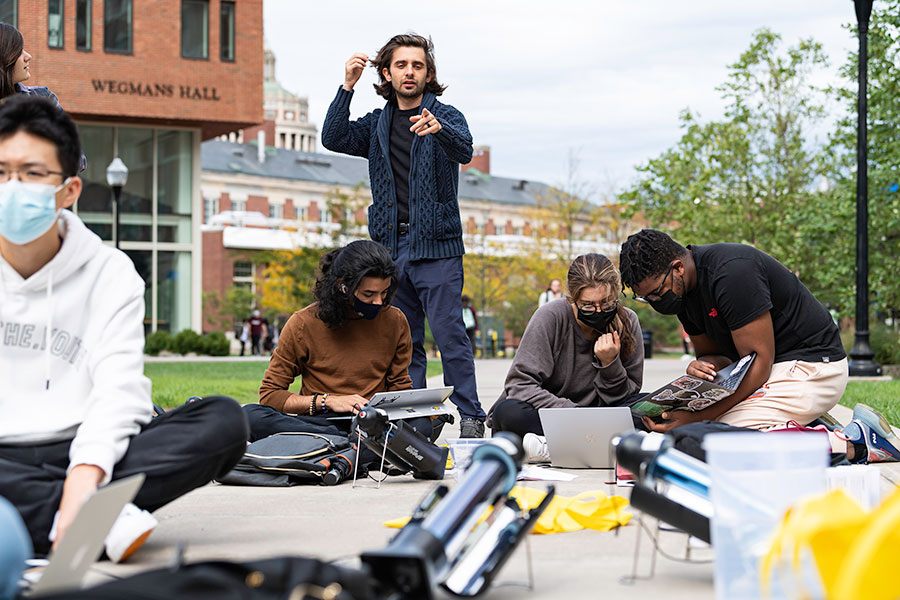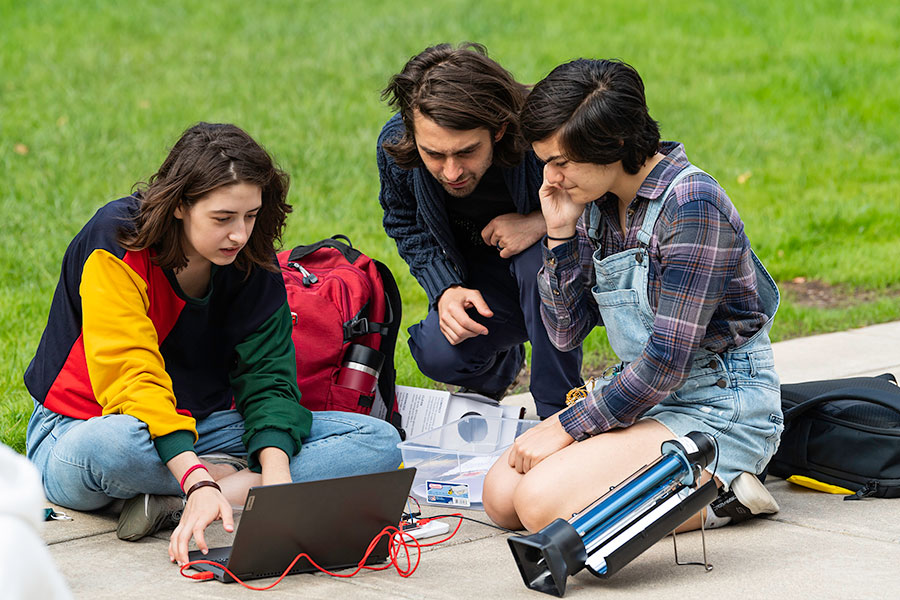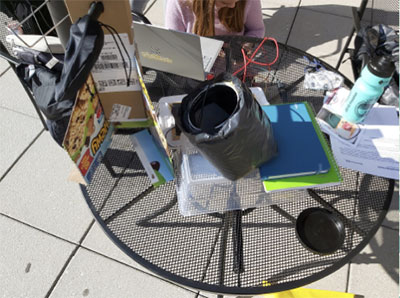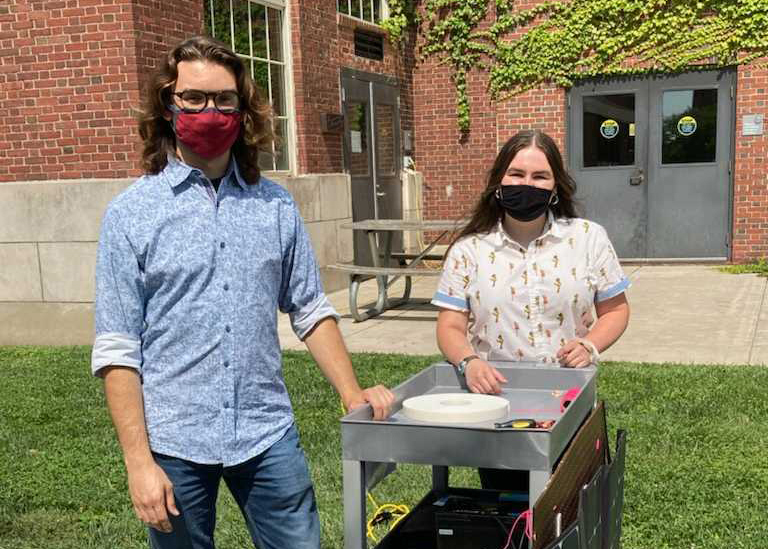Sykes award illuminates next level of sustainable energy class

Students design solar water heaters to test their hypotheses
This fall, University of Rochester students in Marc Porosoff’s course CHE 150: Introduction to Sustainable Energy have been keeping a close eye on the sky as they work in teams to design and build solar hot water heaters.
“I tell them you’re at the whim of the weather. If it’s nice and sunny outside, you’ve got to drop what you’re doing and go outside to collect data,” says Porosoff, an assistant professor of chemical engineering.
Thanks to a $15,000 Sykes Engineering Award from the Hajim School of Engineering and Applied Sciences, Porosoff and two of his teaching assistants, Levi Sunday-Lefkowitz ’22 and Peri Fogel ’24, have been able to “fully reimagine” the first-year CHE 150 course. The new in-class laboratory experiment and team projects they have developed encapsulate the core objectives of the popular course, which include team building and an introduction to thermodynamics.
The introduction to solar heating and thermodynamics involves a classroom experiment that uses a photovoltaic array—built by the two teaching assistants during the summer—to charge a battery, which in turn is used during an in-class demonstration to heat water in a kettle.
“During class we calculated the efficiencies associated with how much energy is lost to convert solar energy to electricity, discharge the battery, and heat the water, and by end of the lecture we found that only about 9 percent of the sunlight heats the water. This is a terrible method of using solar energy to heat water.” Porosoff says.
“This was a great demonstration of the power of sustainable energy, and it was clear that the showcase took a lot of preparation,” first-year student Szymon Kuzniar says. “Additionally, the efficiency of the system—a paltry 9.1 percent—really put into perspective the power of the Sun—and let me set myself a goal of constructing a solar heater that would beat that number.”
"It was a cool experience and demonstrated that all of the principles we learned in class have real life applications," adds first-year student Justin Landis.
Designs showcase students' creativity
The students then split into teams of three to four members each, tasked with designing and building a better solar water heater, using a commercial solar water heating kettle as a starting point and control.
Some of the teams tried to improve on the design of the commercial kettles--for example, experimenting with metal soup cans painted black and placed in a shoebox with reflective material. Other teams came up with entirely different ideas--for example, focusing a magnifying glass on a sphere of water. “The designs were all over the place and showcased the students’ creativity” Porosoff says.
Landis' team, for example, put water in a glass Erlenmeyer flask, which was painted black to increase absorptivity of solar energy. The flask was put inside of a cardboard bowl which was wrapped on the inside with aluminum foil and lined with mirror sheets, all of which was then wrapped in Saran wrap.
“I loved completing the project because it demonstrated one of the ways we can harvest solar energy aside from solar panels, and we could test out our knowledge learned in class to make the most efficient solar water heater as possible,” Landis says.
Two design iterations yielded an average efficiency of 24% across all trials. “Had our group done this project again, we would have changed our design to maximize the amount of water being hit by direct sunlight while also trying to minimize the total area of the design,” Landis says.
The common objective for all the teams was to develop a hypothesis-driven design, and through the scientific method, iteratively develop, test, and improve their prototype. Then using the laws of thermodynamics, they had to explain why it did or did not use sunlight more efficiently to heat water than the commercial control kettle.
“What I especially like about what we are doing this semester is being able to use the solar kettles as a control,” says Fogel. “It’s really awesome to be able to use this kind of design. But then to come up with our own design to compete against it, is really cool.”
High marks from students
First-year student Julia Kubes says the class “has made me really excited to learn more about what I can do with my degree. One of my interests going into college was to go into a field that helps the environment and CHE 150 has taught me a lot about different energy sources and a look into reducing CO2 emissions.
“I’ve met some really great people in this class, “Kubes added. “I’ve made a little study group with other ChemE majors.”
“ChE 150 is the best possible introductory class for the subject,” Kuzniar concurs. “Before coming to the university, I was deathly afraid of being immediately thrown into advanced physics. Luckily, Professor Porosoff thoroughly explained the tools we needed for success in the class before delving into some of the more complicated topics. Given the great focus on unit balance and understanding of the relationships between various equations, I started to feel that I understand physics for the first time in my life.
“The class has been critical for me in understanding how to make connections between concepts that can be made by manipulations of a couple variables. This is a skill which can translate very well into other subjects and classes, for which I am very thankful.”
Landis says he would recommend the class to any prospective engineering student "or any UR student in general. This course combines physics, math, and chemistry to quantify and understand sustainable energy and its uses."

‘I’m excited for the road ahead of me’
The Sykes Award has propelled the course, initially built “largely from scratch,” to the “next level,” says Mitchell Anthamatten, professor and chair of chemical engineering. The award:
- Provided each team with a commercial kettle and a $75 budget for supplies.
- Paid for the supplies Fogel and Sunday-Lefkowitz used to build the photovoltaic array for the in-class demonstration
- Paid for the two teaching assistants to serve as Sykes interns during summer 2021.
“This first year experience is critical to our program because it creates a first impression of chemical engineering for the students and impacts our ability to retain them,” says Anthamatten, who taught CHE 150 before Porosoff took over in Fall 2018.

Even then, the course featured mini design projects involving solar power. However, without a budget, “students would kind of throw things together out of plastic bottles and cardboard or whatever they could find,” Porosoff says.
Also, projects weren’t launched until mid-October, too late in the season for effective data collection.
That’s why Porosoff and Rachel Monfredo, a former lecturer and senior technical associate, applied for the Sykes award when the Hajim School announced an extra round of funding earlier this year. “We wanted to shore up the course and make it reflect the outcomes that we wanted to achieve,” Porosoff says.
“What we were able to accomplish over the summer, and what the students are working with now is a big step up,” says Sunday-Lefkowitz, who took the course the first time Porosoff taught it in 2018. “Where we’re taking the course this semester is above and beyond what we could have dreamed of three years ago.”
For Kubes. the class was pivotal in helping her decide on a major.
“When I applied to UR, I originally intended to major in Chemistry,” she says. “But after my alumni interview with someone who studied ChemE, I was convinced that I should at least start in ChemE and then make the switch later if I wanted. But after taking CHE 150, I’m excited for the road ahead of me. I think UR has a great ChemE department and I know I will receive a great education from this school.”
Adds Kuzniar: “I will be much less scared of the upcoming classes, knowing that I understand the basics of ChemE.“

